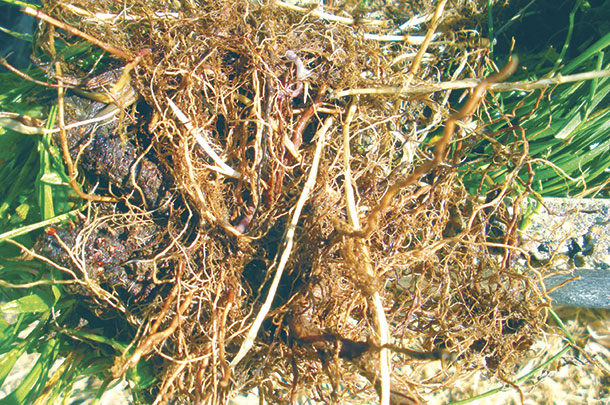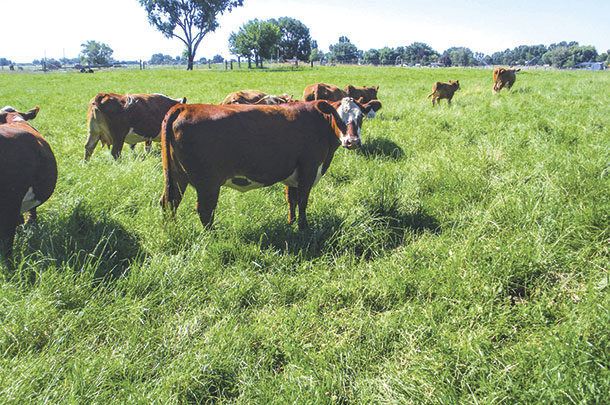(You can fill in the blank with your favorite weedy pest.) For many pasture owners in the Pacific Northwest, weeds represent consumable forage, often fairly high-quality, but they lack dry matter yield, and many possess negative secondary metabolites. Weeds are similar to rocks in the field: Each one is a bit different, and they all occupy space and compete with those desirable cool-season grasses and legumes in irrigated and high-rainfall pastures.
Forage, livestock and climate interactions
Given half a chance, established, perennial cool-season grasses, with or without a complement of perennial legumes, are fierce pasture weed warriors.
The key is to maintain strong grass plants through soil testing and fertility management, maintaining proper soil pH, controlling height of pastures when livestock are initially turned out or after each rotation, and being vigilant on pasture stubble heights near the completion of each grazing cycle.
What drives this forward and makes the entire pasture ecosystem interesting but unpredictable are interactions among forage plants, livestock and climatic factors. Pasture environment changes every day, even monoculture pastures of the same variety, due to those three interaction factors. Available soil moisture is related to soil texture and soil organic matter.
We can’t influence soil texture much but, through crop selection and management, we can influence soil organic matter. Soil organic matter acts like a sponge, holding and releasing moisture to grass roots throughout the grazing season.

This moisture release, even in the hot summer months, helps to release soil nutrients needed for growth and health. Soil pH is influenced by soil moisture, with excess rainfall or irrigation leaching out key cations important to pasture plant cell wall development.
Canopy cover (e.g., amount of grass foliage collecting sunlight and protecting the soil surface) can cool summer soil temperatures at 4 inches by 10ºF or more compared to bare pasture soils. Warmer spring soils stimulate plant growth, but hot summer soils retard growth of those same plants.
Not related to summer soil temperatures, but highly related to retarded summer pasture growth, is the shedding of grass roots.
Finally, seedling weeds do not require a great deal of soil moisture to become established during the late summer and early fall critical period for cool-season pasture grasses in the Pacific Northwest. Collectively, by monitoring all aspects of the soil environment, the first battle against invading pasture weeds can be won.
Weed pressure and stubble height
Often as pastures green up in the spring, what seems like out of nowhere, a new weed crop explodes. Perennial weeds will overwinter but be more noticeable the following late spring or early summer. Annual weeds will invade in previously overgrazed pastures in the fall where sunlight reaches exposed soils, resulting in faster and more noticeable growth in the early spring.
More specifically in the Pacific Northwest, this happens in September. This is the time many phone calls are made starting with, “What do I use to kill ___?”
One example of an invading weed is dandelion. Seeds were likely blown around the pasture, land on bare soil and germinate with fall rains or irrigation water. But for germination and emergence, these seeds must receive sunlight, a likely scenario from overgrazing.
Dandelions are not known to have many negative forage quality factors; however, the taproots produce a gas (ethylene) which attacks neighboring desirable grasses, causing them to mature quickly and die. Higher pasture stubble heights entering the critical September period greatly suppress the invasion of dandelions and other weeds in the fall. We consider 3 inches to be the minimum stubble height for irrigated and high-rainfall pastures year-round.
Pastures entering fall
After a long, hot summer, all pastures are stressed with slowed daily growth rates; some entering fall may have been overgrazed. One aspect of summer growth is higher fiber concentrations of pasture leaves; they simply are not as nutritious as leaves grown in spring or fall.
Grazers search for the highest-quality tissues and, in summer growth, there really isn’t that much high-quality forage to choose from in the pasture. Additionally, the pasture grasses by-and-large are into shedding roots from late June through August, which means new, white roots are not being grown at this time.
As we approach the critical fall growth period of both irrigated and high-rainfall and tame cool-season pastures, keep in mind higher stubble heights are better than lower (ground level or bare soil) to maintain strong perennial pastures and prevent annual weed seeds from establishing. We’ve mentioned 3 inches as the minimum grass stubble height, and this is especially important in the fall.
One important factor in grass stubble height that could differ between grass pastures and grass hay fields is the element of time – days or weeks of regrowth. In hay fields, the cutting interval may be 30 to 50 days between harvests. In pastures, regrowth could be grazed as quickly as 21 days – and often fewer.
Time is the element that introduces an umbrella effect on crop physiology with the interaction of plants, livestock and climatic factors, each changing every single day. When given additional time from prolonged extreme use (or abuse), tame cool-season pasture grasses will rebound.
However, research in rangelands suggests, and we have adopted this knowledge to tame grass pastures, maximum productivity is likely never to be reached again, but this needs to be confirmed with additional research.
2019 pasture productivity
To reduce weedy species pressures in 2019, start making practice changes in September 2018 to prevent weeds from impacting future pasture yield and quality. The unspoken bonus of cool-season pasture grasses is: They are highly flexible and resilient if we closely monitor their growth patterns and then react to support their battle with weeds.
Good luck, as the 2019 pasture production will be determined this fall by what you do or don’t do. ![]()
PHOTO 1: These cattle are owned and grazed by Charlie and Linda Card from Prosser, Washington. The Cards pay attention to year-long grazing management that pays dividends at the end of the year.
PHOTO 2: hese cool-season perennial grass roots are shown in late July. The real roots are brown to orange in color. The white tissues are not roots but rhizomes from quackgrass. Rhizomes never turn brown in color when actively growing. The brown roots are going through the process of root shedding during the summer months. Photos by Steve Fransen.
Don Llewellyn is with Washington State University – Pullman.
Steve Fransen is with the extension/education at WSU Irrigated Ag Research and Extension Center. Email Steve Fransen.









